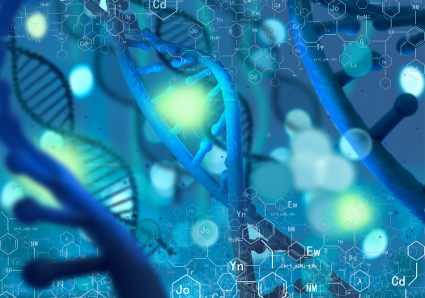Synthetic Biology: Advancing New Applications
by Leslie Mertz

Research in synthetic biology is broadening the field of life sciences through the design and construction of genetically-encoded devices, pathways, networks, and systems.
“We are no longer talking about simply cutting and pasting DNA but actually being able to program the specific nucleotide code that goes into a cell,” says Timothy Lu, associate member of the Broad Institute and director of the Synthetic Biology Group at the Massachusetts Institute of Technology (MIT). This reprogramming lies at the heart of the relatively new and rapidly expanding field of synthetic biology, which is allowing scientists to begin developing, simulating, testing, and building cells for a range of applications.
An example is a product that detects the presence of the dangerous pathogen Listeria in food much more quickly than current methods. Developed by the Cambridge-based start-up company Sample6, which was co-founded by Lu and Michael Koeris when the two were graduate students, the product involves engineering a bacteriophage to identify and then tag Listeria with a “genetic circuit” that causes it to make luciferase. “Because luciferase is an enzyme that generates light, we can then use a very simple luminometer device to detect the light and easily measure whether a sample is infected,” Lu explains.
The product, called DETECT, reduces detection time from one or two days with current methods to just six hours, Koeris says. In addition, Sample6 is currently working on a product to identify pathogens in humans. This would allow doctors to identify the particular pathogen affecting an individual patient, and prescribe targeted rather than broad-spectrum antibiotics.
Another example of the potential impact of synthetic biology is a bacterial sensing system designed to pick up different disease states in patients designed by Jeffrey Way and his research group at the Wyss Institute for Biologically Inspired Engineering at Harvard Medical School.
To develop the system, the researchers took two proteins (cI and Cro) from a bacteriophage, placed them next to the lacZ gene in E. coli, and then put the engineered E. coli into a pill for the patient to ingest. When the E. coli comes into contact with a target pathogen, the cI/Cro states change—one turns on and the other turns off, which provides a clear indication of whether the patient has been exposed. “If the bacteria experience something when they’re in the gut—even if it’s temporary—when they get pooped out, you can plate them out on an agar plate to see if the cI/Cro states have changed,” he explains. Way sees a potential for engineered probiotic E. coli to colonize the intestine and, once there, to not only detect a pathogenic attack, but to actually release a targeted therapy. Such biologically engineered E. coli could also be designed to distinguish exposure to chemicals ranging from toxins to explosive materials, Way says.
Expanding the playing field
In an effort to advance research possibilities, the Foundry in Cambridge, Massachusetts, is embarking on a major project to design, fabricate, and test large sequences of DNA—20,000 bases long and more. This will ultimately allow an academic, commercial, or government lab to produce new research tools, unique pharmaceuticals, novel materials, and just about anything in between both quickly and inexpensively, according to Foundry leaders.
The Foundry received a five-year, US$32 million contract from the Defense Advanced Research Projects Agency (DARPA) in 2015, and has brought in about three dozen new staff to develop a streamlined design-build-test cycle. “Around design, for instance, we have advanced new software that you can basically use as the genetic equivalent of a CAD tool to research your designs efficiently, and in ways that you simply cannot do on Excel or in Word,” says Rob Nicol, a Foundry co-founder and director of Technology Labs at the Broad Institute of Harvard and MIT. On the build side, he points to advanced molecular-biology and automation tools that access the designs from that software, and connect to robotic systems, which realize them physically as DNA circuits and constructs that instruct cellular pathways.
Researchers are already benefiting from the Foundry’s capabilities. That includes the research group of Foundry co-founder Christopher Voigt, MIT biological engineering professor and co-director of MIT’s Synthetic Biology Center. His group is using the Foundry to engineer the complex pathway that certain bacteria use to make iron oxide nanocrystals. His group has been working in collaboration with the Department of Defense, which is interested in the crystals for antennas and other applications. Voigt’s goal is to manipulate the pathway. “We want to control the size, the shape, and the composition of the nanocrystals, and do it for our purposes versus what the pathway in a biological system had in mind,” he says.
The Foundry is also working with a research group at the University of California San Francisco to reprogram clusters of genes for use in exploring the microbiome and the molecules produced by microbes in the microbiome, and is partnering with a pharmaceutical company to scan the molecules for interesting immunological, anti-inflammatory, or other properties that might be useful as therapeutics. Applications also extend to materials, agricultural, and other industries too, adds Ben Gordon, director of the Foundry. For instance, he notes that the Foundry is working with a large European chemical company to engineer yeast to make green plastics, and with global researchers to re-engineer the bacterial processes behind nitrogen fixation that is essential to plant growth.
There are indeed many opportunities in the field of synthetic biology, especially since technologies are advancing to the point that even small groups of scientists can make important contributions and become a force of innovation, says molecular biologist Jeffrey Kim. Kim is a co-founder of Radiant Genomics of Emeryville, California, which is using synthetic biology as a new approach to natural-product discovery. “Through synthetic biology, we are going to see a lot of small companies developing products that impact a great deal of people.”
The possible applications of synthetic biology are nearly endless, adds Way. “Once you start thinking about potential applications, ideas just pop into your head, and you realize that the only thing that’s limiting is your creativity.”
Leslie Mertz is a freelance science writer and author living in Northern Michigan.
For related information, see:
http://spectrum.ieee.org/biomedical/devices/dna-manufacturing-enters-the-age-of-mass-production







 Leslie Mertz, Ph.D. is an experienced science, technology, medical, and environmental writer who has written for numerous magazines, and other media and publishing outlets. She has authored nine books, co-authored a 10th, and written a wide variety of articles and chapters for additional books.
Leslie Mertz, Ph.D. is an experienced science, technology, medical, and environmental writer who has written for numerous magazines, and other media and publishing outlets. She has authored nine books, co-authored a 10th, and written a wide variety of articles and chapters for additional books.